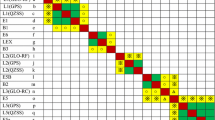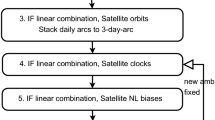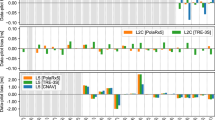Abstract
A tightly combined observational model assumes a single reference satellite for all observations from different GNSS systems. We analyze the effect of different frequencies on different-frequency inter-system mixed double differences (DFMDDs) and derive an upper limit for a permissible inter-frequency difference. To mitigate inter-frequency differences, we propose using combinations of phase observations from different GNSS systems to obtain virtual observations having the same or similar frequency. A new carrier phase linear combination method is proposed for the DFMDD, called limited lane number search method, which increases the permissible inter-frequency difference. We demonstrate the feasibility of the search method from a geometrical perspective. Finally, we provide selected combinations with desirable properties for DFMDD. Optimal and independent integer combinations are suggested for short and long baselines.









Similar content being viewed by others
References
Cocard M, Bourgon S, Kamali O, Collins P (2008) A systematic investigation of optimal carrier phase combinations for modernized triple-frequency GPS. J Geodesy 82(9):555–564
Deng C, Tang W, Liu J, Shi C (2013) Reliable single-epoch ambiguity resolution for short baselines using combined GPS/BeiDou system. GPS Solut 18(3):375–386
Feng Y, Rizos C (2005) Three carrier approaches for future global, regional and local GNSS positioning services: concepts and performance perspectives. In: Proceedings of the ION GNSS 2005, Institute of Navigation, Long Beach, CA, USA, September 13–16, pp 2277–2787
Gu S (2013) Research on the zero-difference in-combined data processing model for multi-frequency GNSS and its applications. Dissertation, Wuhan University
He H, Li J, Yang Y, Xu J, Guo H, Wang A (2013) Performance assessment of single- and dual-frequency BeiDou/GPS single-epoch kinematic positioning. GPS Solut 18(3):393–403
Hofmann-Wellenhof B, Lichtenegger H, Wasle E (2008) GNSS—global navigation satellite systems. Springer, Vienna. doi:10.1007/978-3-211-73017-1
Julien O, Alves P, Cannon ME, Zhang W (2003) A tightly coupled GPS/GALILEO combination for improved ambiguity resolution. In: Proceedings of the ION GNSS 2003, European navigation conference, Graz, Austria, 2003
Khodabandeh A, Teunissen PJG (2016) PPP-RTK and inter-system biases: the ISB look-up table as a means to support multi-system PPP-RTK. J Geodesy. doi:10.1007/s00190-016-0914-9
Leick A, Li J, Beser J, Mader G (1995) Processing GLONASS carrier phase observations: theory and first experience. In: Proceedings of the ION GPS 1995, Institute of Navigation, Palm Springs, CA, September 12–15, pp 1041–1047
Li J, Yang Y, He H, Xu J, Guo H (2012) Optimal carrier phase combinations for triple-frequency GNSS derived from an analytical method. Acta Geodaetica Cartogr Sin 41(06):797–803
Lou Y, Gong X, Gu S, Zhang F (2016) Algorithm and results analysis for GPS + BDS inter-system mix double-difference RTK. J Geodesy Geodyn 36(01):1–5
Montenbruck O, Hauschild A, Hessels U (2011) Characterization of GPS/GIOVE sensor stations in the CONGO network. GPS Solut 15(3):193–205
Odijk D, Teunissen PJG (2013) Characterization of between-receiver GPS-Galileo inter-system biases and their effect on mixed ambiguity resolution. GPS Solut 17(4):521–533
Odijk D, Nadarajah N, Zaminpardaz S, Teunissen PJG (2016) GPS, Galileo, QZSS and IRNSS differential ISBs: estimation and application. GPS Solut. doi:10.1007/s10291-016-0536-y
Odolinski R, Teunissen PJG (2016) Single-frequency, dual-GNSS versus dual-frequency, single-GNSS: a low-cost and high-grade receivers GPS-BDS RTK analysis. J Geodesy. doi:10.1007/s00190-016-0921-x
Paziewski J, Wielgosz P (2015) Accounting for Galileo-GPS inter-system biases in precise satellite positioning. J Geodesy 89(1):81–93
Paziewski J, Wielgosz P (2016) Investigation of some selected strategies for multi-GNSS instantaneous RTK positioning. Adv Space Res. doi:10.1016/j.asr.2016.08.034
Paziewski J, Sieradzki R, Wielgosz P (2015) Selected properties of GPS and Galileo-IOV receiver intersystem biases in multi-GNSS data processing. Meas Sci Technol 9(26):95008. doi:10.1088/0957-0233/26/9/095008
Richert T, El-Sheimy N (2007) Optimal linear combinations of triple frequency carrier phase data from future global navigation satellite systems. GPS Solut 11(1):11–19
Wang J, Rizos C, Stewart MP, Leick A (2001) GPS and GLONASS integration: modeling and ambiguity resolution issues. GPS Solut 5(1):55–64
Wu Z, Bian S, Ji B, Xiang C, Jiang D (2016) Short baseline GPS multi-frequency single-epoch precise positioning: utilizing a new carrier phase combination method. GPS Solut 20(3):373–384
Zhang X, He X (2015) BDS triple-frequency carrier-phase linear combination models and their characteristics. Sci China (Earth Sciences) 58(06):896–905
Zhang X, He X (2016) Performance analysis of triple-frequency ambiguity resolution with BeiDou observations. GPS Solut 20(2):269–281
Zhang X, Li P (2016) Benefits of the third frequency signal on cycle slip correction. GPS Solut 20(3):451–460
Zhang W, Cannon ME, Julien O, Alves P (2003) Investigation of combined GPS/GALILEO cascading ambiguity resolution schemes. In: Proceedings of the ION GPS/GNSS 2003, Institute of Navigation, Portland, Oregon, September 9–11, pp 2599–2610
Acknowledgements
This work was financially supported by the National Natural Science Foundation of China (No. 41174006), China Postdoctoral Science Foundation (Nos. 201003772 and 20100481458).
Author information
Authors and Affiliations
Corresponding author
Rights and permissions
About this article
Cite this article
Li, G., Wu, J., Zhao, C. et al. Double differencing within GNSS constellations. GPS Solut 21, 1161–1177 (2017). https://doi.org/10.1007/s10291-017-0599-4
Received:
Accepted:
Published:
Issue Date:
DOI: https://doi.org/10.1007/s10291-017-0599-4




